A Look at Officer Education at the Maneuver Center of Excellence
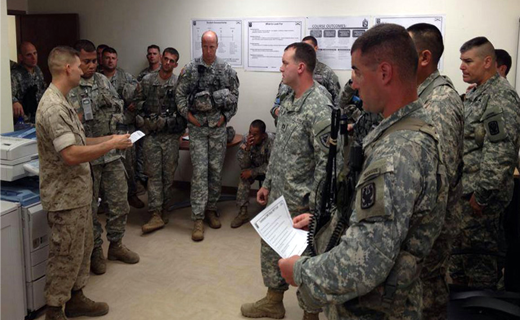
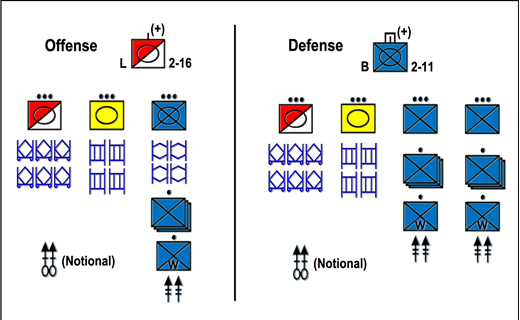
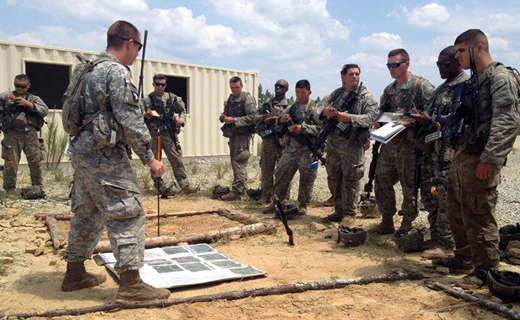
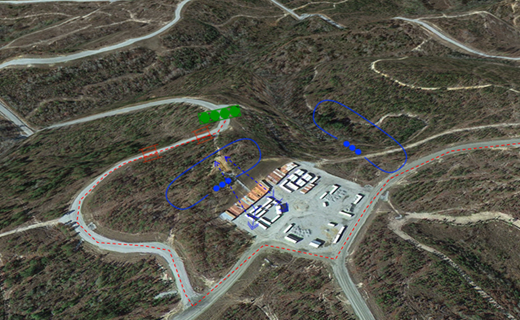
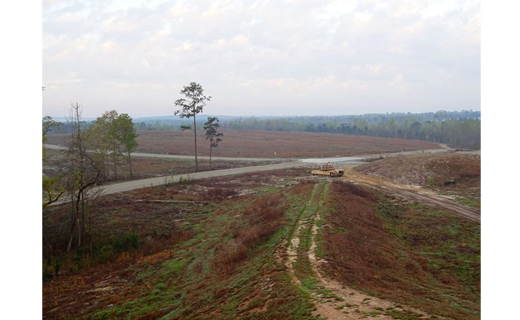
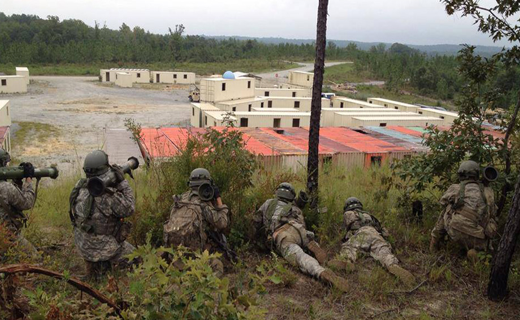
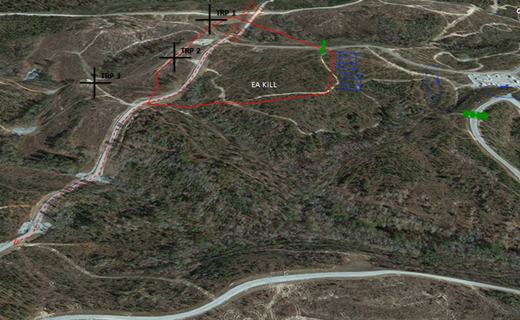
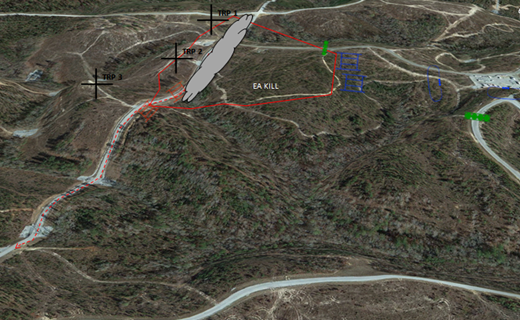
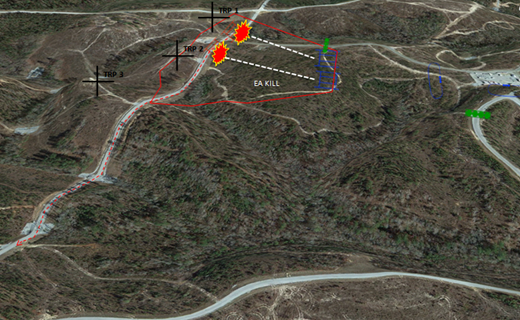
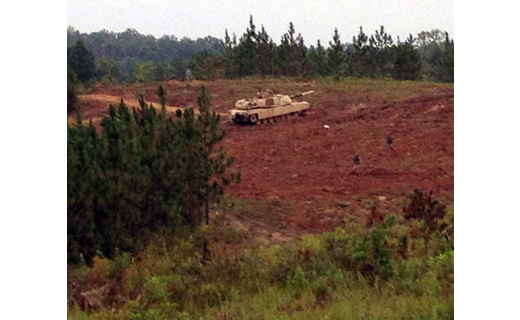
The Maneuver Center of Excellence’s (MCoE) Armor Basic Officer Leadership Course (ABOLC) hosted a combined field-training exercise (FTX) that brought together ABOLC, Infantry Basic Officer Leadership Course (IBOLC) and Maneuver Captain’s Career Course (MCCC) students for a three-day, multi-echelon leader-development (MELD), combined-arms FTX at Fort Benning’s Good Hope Maneuver Training Area (GHMTA) in December 2013 and August 2014.
More than 360 officers from ABOLC, IBOLC and the MCCC participated in the events; the students participating in the combined FTXs were all in their final phase of their respective courses. Of the 360 officers, eight MCCC students and 32 BOLC students planned and briefed troop- and platoon-level operations orders (OPORDs). Following OPORD briefs, the students led company- and platoon-level operations as part of a combined-arms team.
The exercises illuminated multiple recurring trends that crossed school and branch boundaries. Officers from both branches and from each of the three schools displayed similar deficiencies across the board. While this article analyzes specific incidents from the training, these incidents are not isolated occurrences but rather are representative of repetitive shortcomings in student performance.
These incidents serve to illustrate shortcomings in education and training across the MCoE’s officer-training courses. The primary shortcomings include:
- Students did not understand combined-arms theory and the subsequent application thereof;
- Students did not understand how to effectively employ scout platoons;
- Students were not familiar with how to effectively employ indirect fires in support of maneuver; and
- Students did not plan anti-armor considerations.
The purpose in pointing out these shortcomings is twofold: one, to help the MCoE see itself; and two, to provide the operational force with ideas to assist in constructing home-station leader-development programs.
Combined FTX
Each FTX consisted of two iterations of troop-leading procedures (TLPs), followed by force-on-force operations. The students were divided into two notional companies, each with a similar task organization. Both teams consisted of a humvee-based scout platoon, a tank platoon and two infantry platoons.
The difference between the two companies’ task organizations was that the attacking force had a Bradley-equipped infantry platoon, while the defending company had only two dismounted infantry platoons (Figure 2). ABOLC students manned tank crews and scout trucks, while IBOLC students manned the infantry platoons (mounted and dismounted).
The notional companies were led by captains from MCCC. Before their arrival at GHMTA, the MCCC captains were given a written battalion OPORD. The captains developed a company OPORD, briefed their OPORD to their respective company and then led the company through mission execution.
ABOLC and IBOLC students served as the platoon leaders for each mission. As such, they too received an OPORD and were evaluated by their respective cadre on their ability to conduct TLPs and lead their respective platoons during mission execution.
The companies, platoons and crews conducting the combined FTX were not organic, trained teams and units, but rather were a group of students coalesced to meet training requirements. With this in mind, the cadre was not overly concerned with how effective each team was during battle. Instead, the cadre was more concerned with student planning, decision-making and eagerness to lead because it provided a better metric for assessing a student’s level of understanding and proficiency with course concepts rather than who “won” a battle.
Combined-arms theory and application
The Army defines combined arms as “[t]he synchronized and simultaneous application of arms to achieve an effect greater than if each arm was used separately or sequentially.”1 The Army defines combined-arms maneuver (CAM) as “[t]he application of the element of combat power in unified action to defeat enemy ground forces; to seize, occupy and defend land areas; and to achieve physical, temporal and psychological advantages over the enemy to seize and exploit the initiative.”2
A more thorough definition of combined arms can be found in retired LTC Robert Leonhard’s The Art of Maneuver: Maneuver-Warfare Theory and AirLand Battle. Leonhard states, “By combining the various combat arms into a single organization, we can compensate for each arm’s weakness through another arm’s strength. … When employed correctly, the various combat arms serve to complement each other with respect to the enemy. In other words, for the enemy to successfully defend himself from one arm, he must become vulnerable to another. … It is for this reason we must conclude that it is generally wrong to attack an enemy system with a like system. Such a choice automatically presumes a fair fight in terrain favorable to the enemy. … Rather, we want to defeat enemy systems with unlike systems in terrain that maximizes our advantages and puts the enemy at a disadvantage.”3
It was apparent during the combined FTXs that a preponderance of officers in leadership positions demonstrated a limited understanding of combined-arms theory. This lack of understanding became evident through the ineffective use of scout platoons and lack of anti-armor considerations, as well as poor planning and integration of indirect fires. In every case, leaders thought, planned and used each arm in isolation or sequentially, instead of in the synergistic manner called for by combined-arms doctrine and combined-arms theory. Examples to illustrate this statement will be examined on the pages that follow.
Anti-armor operations
Officers from ABOLC, IBOLC and MCCC demonstrated limited understanding of anti-armor doctrine, both in the offense as well as in the defense. Field Manual (FM) 3-21.91, Tactical Employment of Anti-Armor Platoons and Companies, states that, “Anti-armor elements operate as part of a combined-arms team. [T]hey use long-range fires to destroy, suppress and/or fix enemy combined-arms forces, serve as a fixing force for other maneuver elements and employ massed fires and depth of position to achieve their desired effects.”4 FM 3-21.91 states that the fundamentals of anti-armor units include “[m]utual support, flank-shot engagement, standoff, cover and concealment, employment in depth and employment as part of the combined-arms team.”5
Anti-armor companies and platoons were not employed during the combined FTX; however, the defending force used dismounted, anti-armor squads. The dismounted anti-armor squads achieved a small amount of success during the battles, but had the fundamentals of anti-armor employment been better understood and applied in conjunction with engagement-area development, the anti-armor elements could have achieved far greater, more rapid success. Conversely, tank platoons often played into the hands of the anti-armor squads by not thinking through potential anti-armor ambush locations.
To illustrate, during the combined FTX in August 2014, the defending force made good use of terrain by employing a blocking obstacle to the west of Patriot Military Operations in Urban Terrain (MOUT) Site, the MOUT site in Fort Benning’s GHMTA the defenders were charged with retaining (Figure 4). The obstacle was at a bend in the road, which made it invisible to tanks as they moved down the road. The obstacle was effectively tied into terrain in such a way that a tank could not maneuver around the obstacle – to the east of the tank was untrafficable high ground, and to the west of it was terrain severely restricted to tank movement.
Because the tanks had no breaching or engineer assets, this left them with one option: turn around and depart along the path on which they came. Watching from the high ground adjacent to the obstacle, it became apparent how vulnerable the tank was at this point. Had the defending force better understood the fundamentals of anti-armor employment and synthesized those concepts with the steps of engagement-area development, they could have easily killed the tank section at the obstacle.
However, the commander for the defending force did not make that connection. Instead, he had to reposition his anti-armor squad from a position in the MOUT site to the elevated terrain adjacent to the obstacle in an attempt to kill the tank at the obstacle. This lapse in judgment allowed the tank to displace while the anti-armor squad was moving on foot from the MOUT site to the anti-armor ambush location.
Situations such as this one are easily transferable to an urban environment with an asymmetric threat. The scenario described could just have easily occurred in Afghanistan, Iraq, Syria or any number of contemporary battlefields. In a posting in Small Wars Journal, Dennis Lowe states, “Since [the Islamic State in Iraq and Lebanon]6 began its conquest of Iraq earlier this year, it has proved adept at employing a number of anti-tank [AT] systems such as 9K11 Kornet [anti-tank guided missiles], [rocket-propelled grenade] variants and the Yugoslavian M70 Osa rocket launcher. During these engagements, militants damaged at least 28 Iraqi M1A1 Abrams tanks, five of which suffered full armor penetration. Clearly, ISIL understands how to target our tanks’ weak spots and accurately employ AT fires against them.”7
Therefore, it is imperative that combat-arms officers remain cognizant of the anti-armor threat. To counter those threats, we must take a proactive approach to understanding anti-armor doctrine. More importantly, we must realize that the anti-armor threat is not solely a problem for tanks and Bradley Fighting Vehicles, but is easily transferable to any mounted platform the Army puts in the field.
Reconnaissance and security operations
Cavalry formations, including scout platoons, are fielded to serve as the eyes and ears of their higher headquarters. FM 3-20.96, Reconnaissance and Cavalry Squadron, states, “Reconnaissance operations enhance the higher commander’s ability to operate inside the enemy’s decision cycle and allow him to maneuver his assets so they can take advantage of opportunities to exploit enemy weaknesses. Reconnaissance is key to retaining initiative and freedom to maneuver. It helps the squadron’s higher commander and staff to determine which routes are suitable for maneuver and where the enemy is strong and weak. They provide a means to answer [information requirements] and fill gaps in existing intelligence. Timely intelligence allows the squadron’s higher commander to concentrate appropriate combat power against decisive points at the time and place of his choosing.”8
During the combined FTXs, most mission commanders (MCCC officers) were ineffective in employing their scout platoons. Many students appeared to lack true understanding of reconnaissance, which adversely affected their employment considerations and techniques during the exercise. Also, they could communicate the fundamentals of reconnaissance and security operations – ironically, while they did not have the breadth of experience or prerequisite training and education to transfer those concepts from the classroom to the battlefield.
Furthermore, they were unable to link their organic reconnaissance assets with their scheme of maneuver. The scout platoons were used as maneuver platoons instead of as a reconnaissance asset, thus negating their ability to answer priority intelligence requirements and paint the picture of the operating environment for the mission commander. In almost every instance, scout platoons were given tasks such as “route reconnaissance” but were expected to drive down the road and engage all opposing elements in which they came into contact.
In improperly using the scout platoons, mission commanders continually found that their scouts were not oriented on the reconnaissance objective, were decisively engaged and were denied freedom of maneuver, thus violating many of the fundamentals of reconnaissance, negating their ability to conduct reconnaissance.
The lack of understanding and effective employment of reconnaissance assets can be directly attributed to the officers’ inability to transition conceptual combined-arms doctrine, synthesize it with Cavalry doctrine and apply it during the planning and execution phases of training. This is a direct consequence of a lack of education, training and experience with reconnaissance and security operations – compounded by a parochial approach to training combat-arms officers – that negates the realities of the contemporary Army.
Indirect fires
A critical component of all combined-arms operations is the ability to effective employ indirect fires. During the combined FTXs, officers of both branches from all three schools showed an extremely limited understanding of offensive and defensive fire planning and of how indirect fires are employed during the reconnaissance/counter-reconnaissance fight.
Furthermore, the employment of indirect fire-delivered smoke was never employed on the battlefield to screen movement or obscure friendly forces from observation by the enemy. An example from the combined FTX involved a mission commander tasking his tank platoon to move across a 600-meter linear danger area without using anything to screen his movement.
The linear danger area was perpendicular to an intervisibility line 400 meters to the south (Figure 6). Employing artillery or mortar-delivered smoke at this point on the battlefield would have greatly increased the platoon’s chances of success and survival in crossing the danger area (Figure 7).
The defending force had a tank section positioned behind the intervisibility line which, upon identifying the enemy moving uncovered 400 meters to their front, executed a berm drill: rapidly emerging from behind the intervisibility line, then engaging and destroying two of the opposing tanks before disappearing back behind the berm before the other tank section could identify its location (Figure 8).
To the observer of this scenario, it highlighted a lack of understanding of offensive fire planning. Also, the scenario highlighted a lack of understanding in how to effectively employ artillery or mortar-delivered smoke on the battlefield. A quick map reconnaissance had shown the area to be dangerous to maneuver without smoke to screen friendly movement; however, during the planning process, neither the mission commander nor the tank-platoon leader planned for smoke or any other fires or obscuration to assist in crossing the danger area.
Both the mission commander and the platoon leader had planned fires, but their understanding of fires employment in support of the maneuver plan was insufficient. Their understanding of indirect-fire planning in support of offensive and defensive operations was limited to the point that it negatively affected their ability to effectively operate as a combined-arms team. Because of this, they failed to integrate indirect fires into the maneuver plan and, instead, developed a parallel fire plan that served its own ends and was disjointed from the operation’s overall purpose.
This echoes the assessment in a September 2014 semi-annual report written by U.S. Army Training and Doctrine Command’s capability manager for the armored brigade combat team (ABCT), which discussed rotational units’ integration of fire and maneuver at the National Training Center (NTC): “[The units] demonstrate a lack of understanding on how to integrate fire support with maneuver.”
Recommendations
Combat-arms officers must increase their understanding of combined-arms theory to better allow them to understand the combined-arms team and CAM. To do this, they must study.
- A great place for combat-arms officers to start is with Leonhard’s book, which does a fantastic job of explaining CAM and maneuver-warfare theory to the reader.
- Combat-arms officers would also greatly benefit from reading retired COL Douglas MacGregor’s Warriors Rage: The Great Tank Battle of 73 Easting, which provides a great account of CAM and reconnaissance operations during the Battle of 73 Easting.
- Roy Appleman’s East of Chosin, Entrapment and Breakout in Korea, 1950 provides a great illustration of the destruction wrought upon 31st Infantry Regiment, 7th Infantry Division, during the Korean War, due in large part to their inability to effectively fight as a synchronized combined-arms team.
- Fort Benning’s Maneuver Self-Study Program (MSSP) provides many other readings that can help solidify a combat-arms officer’s foundational understanding of combined-arms operations. MSSP can be found in the Donovan Research Library in Bldg. 70 (beside the MCoE headquarters building) and on-line at http://www.benning.army.mil/mssp/.
The MCoE must also break down walls and build bridges; parochial approaches to officer training must cease. Infantry officers will serve in command-and-staff positions in Armor and Cavalry units; this is no longer an anomaly, and officer training and education at the MCoE must catch up with reality. Likewise, the existence of combined-arms battalions (CABs) creates the need for officers of both branches to understand the employment considerations for tank companies and mechanized-infantry companies.
Further, all CABs and infantry battalions across each of the Army’s brigade combat teams (BCTs) contain a scout platoon. Officers serving on BCT staffs must possess a baseline understanding of the role and employment considerations of those platoons.
Therefore, the MCoE must incorporate the Cavalry Leader’s Course (CLC) into MCCC. Parochial outlooks on training – coupled with insufficient availability for 100-percent attendance in the course and the course’s elective nature – make the CLC an antiquated approach to training and educating officers for troop-, squadron- and brigade-level reconnaissance and security operations. MCCC must allocate time in the program of instruction (PoIs) for reconnaissance and security operations in the course’s company and battalion phases. The MCoE must mandate that only officers and noncommissioned officers who have served in Cavalry formations can instruct reconnaissance and security modules to ensure students are receiving instruction from experienced leaders from relevant, applicable backgrounds.
Expanding on this idea, the MCoE must incorporate reconnaissance and security instruction into IBOLC to begin developing infantry officers for leadership and staff positions in reconnaissance and security formations. Instructors from ABOLC, Army Reconnaissance Course (ARC) and/or CLC must provide the instruction. Perhaps an instructor-exchange program within 199th Infantry Brigade9 and between 199th Infantry Brigade and 316th Cavalry Brigade10 could allow this program to take shape.
The MCoE must ensure anti-armor employment considerations (friendly threat, offensive, defensive, open terrain, restrictive terrain, urban terrain) are taught to all officers. The benefits of this for combat-arms officers will include:
- More awareness of potential death traps;
- More awareness of how to negate the effects of armor on the battlefield; and
- More familiarity with how to employ their anti-armor assets in both offensive and defensive operations.
Also, all officers will better understand the vulnerabilities of tanks and Bradleys in urban areas and in restrictive terrain.
GEN George S. Patton wrote, “Our mortars and our artillery are great weapons when they are firing. When they are silent, they are junk. See that they keep firing!”11 However, Soldiers cannot be expected to effectively employ mortars and artillery if they are not trained well enough on how to employ these weapons systems. What’s more, employing indirect fires as part of counter-reconnaissance and security operations is a key component to Cavalry operations. As such, all combat-arms officers must maintain a moderate level of proficiency with indirect fires and for planning indirect fires. Therefore, it is imperative the MCoE ensures that courses are dedicating the necessary time in PoIs to develop a working knowledge of how to employ fires on the battlefield as part of the combined-arms team.
Conclusion
In conclusion, the combined-arms MELD combined FTXs run by ABOLC provided the officers who participated great opportunities to plan and execute platoon- and troop-level combined-arms operations. During each combined FTX, a number of trends in officer training and education appeared. These trends include the lack of understanding of:
- Combined-arms operations;
- Effectively planning and integrating indirect fires;
- Effectively employing scout platoons; and
- Planning anti-armor operations.
The MCoE must aggressively address each deficiency to develop more adept combined-arms officers for the operational force.
Further, junior officers must be self-aware and identify their own shortcomings in CAM, and they must rigorously pursue self-development to address these deficiencies. Professional reading, learning through observation of peers and self-study – including the MCoE’s MSSP – are great places to begin the journey.
Notes
1 Army Doctrinal Reference Publication 3-0, Unified Land Operations, Washington, DC: Department of the Army, 2012.
2 Army Doctrinal Publication 3-0, Unified Land Operations, Washington, DC: Department of the Army, 2011.
3 Robert Leonhard, The Art of Maneuver: Maneuver-Warfare Theory and AirLand Battle, New York: Presidio Press, 1991.
4 FM 3-21.91, Tactical Employment of Anti-armor Platoons and Companies, Washington, DC: Department of the Army, 2002.
5 Ibid.
6 Also formerly known as ISIS (the Islamic State in Iraq and Syria) and currently called simply the Islamic State.
7 Dennis A. Lowe, “Employing Armor Against the Islamic State: The Inevitable Urban Combined-Arms Fight,” Small Wars Journal, Sept. 26, 2014.
8 FM 3-20.96, Reconnaissance and Cavalry Squadron, Washington, DC: Department of the Army, 2010.
9 199th Infantry Brigade is headquarters for 2-16 Cavalry (ABOLC), 2-11 Infantry (IBOLC), MCCC and 3-11 Infantry (Officer Candidate School).
10 316th Cavalry Brigade is headquarters for ARC and CLC.
11 GEN George S. Patton Jr., War As I Knew It, New York: Houghton Mifflin Harcourt Publishing Company, 1947.
 email
email print
print